Optimal Scheduling of Power System Incorporating the Flexibility of Thermal Units
Abstract
1. Introduction
- (1)
- Considering both subjective and objective factors, a comprehensive evaluation index system for TPU flexibility is designed which covers the technical and economic characteristics of TPU.
- (2)
- A power system optimal scheduling model that considers the flexibility of each unit is proposed. The model takes both the economics and flexibility of the system operation into account which compensates for the greater amount of net load fluctuations and makes the scheduling plan more transparent.
- (3)
- The model presented in this article can increase the market competitiveness of flexible units and thus increase the power system flexibility.
2. Flexible Regulation Characteristics of the TPU
2.1. Technical Characteristics
2.1.1. Adjustable Capacity
2.1.2. Ramping Rate
2.1.3. Adjustment Period
2.2. Economic Characteristics
2.2.1. Operation Costs
2.2.2. Start-up Costs
2.3. Selection of Flexibility Indexes of TPU
3. TPU Flexibility Evaluation Index System
3.1. Analytic Hierarchy Process
- Establish a hierarchy, as shown in Figure 4.
- Consistency test of the judgment matrix.The quantitative indicator that measures the degree of inconsistency is called the consistency indicator (CI):where λmax is the largest eigenvalue of the comparison judgment matrix, and the expert’s judgment becomes inconsistent with an increase in the number of indicators. In order to measure the CI standard, Satty et al. proposed the use of the random consistency ratio (CR < 0.1) to correct the consistency index [29].
- Calculate the weight of the indicator.The formulas for calculating the weight of each index using the weight vector calculation method of the product square root method are as follows:where: ri is the geometric mean of the elements of each row in the judgment matrix A; pj is the weight coefficient of index j.
3.2. Entropy Method
- Calculate the feature weight of the i-th evaluated object under the j-th index:
- Calculate the entropy value (ej) of the j-th indicator:
- Calculate the difference coefficient matrix of the indicator:
- Calculate the weight coefficient:
3.3. Construction of the Comprehensive Weighting Model
- This paper uses the commonly used Lagrangian multiplier method for comprehensive empowerment:where wj is the calculated comprehensive weight coefficient.
- The assembly model used in this paper is a linear “addition” integrated assembly model.where Flexi is the comprehensive flexibility evaluation score of TPU i; n is the total number of indicators; xij is the observation value of index j of TPU i.
4. Optimization Scheduling Model Considering TPU Flexibility
4.1. Objective Function and Constraints
4.1.1. Objective Function
4.1.2. Restrictions
4.2. System Flexibility Assessment
4.2.1. System Flexibility Assessment Indicators
4.2.2. Power Generation Plan Flexibility Assessment Process
- (1)
- Input the unit parameters, the comprehensive flexibility evaluation value, and the load and wind data and determine the flexibility factor (α) in Equation (19).
- (2)
- Based on the wind power and load forecast data, determine the power generation plan, obtain the upward adjustment flexibility supply ({RUt}) and the downward adjustment flexibility supply ({RDt}), and set the simulation frequency (M).
- (3)
- Based on Equation (27), obtain the up-regulated flexibility requirement sequence ({updt}) and down-regulated flexibility requirement sequence ({dndt}) during the scheduling period.
- (4)
- Using the WP historical prediction error distribution within the scheduling range, use the Monte Carlo simulation to generate the prediction error timing ({εt}).
- (5)
- According to the WP prediction error sequence ({εt}) generated in step 4, modify the up-regulated flexibility requirement sequence and down-regulated flexibility requirement sequence to obtain ({}) and ({}).
- (6)
- Set the intermediate variables γu and γd to record the simulation results, and finally get the upward flexibility deficiency probability (PUFNS) and downward flexibility deficiency probability (PDFNS).
5. Case Study
5.1. Unit Flexibility Evaluation
5.2. The Impacts of Uncertainty on the System
5.3. The Impacts of the TPU Flexibility on the System
5.4. Sensitivity Analysis
6. Conclusions
Author Contributions
Funding
Conflicts of Interest
Appendix A
| Unit 1 | Unit 2 | Unit 3 | Unit 4 | Unit 5 | Unit 6 | Unit 7 | Unit 8 | Unit 9 | Unit 10 | |
|---|---|---|---|---|---|---|---|---|---|---|
| Pmax (MW) | 455 | 455 | 130 | 130 | 162 | 80 | 85 | 55 | 55 | 55 |
| Pmin (MW) | 150 | 150 | 20 | 20 | 25 | 20 | 25 | 10 | 10 | 10 |
| a ($/h) | 1000 | 970 | 700 | 680 | 450 | 370 | 480 | 660 | 665 | 670 |
| b ($/MWh) | 16.19 | 17.26 | 16.60 | 16.50 | 19.70 | 22.26 | 27.74 | 25.92 | 27.27 | 27.79 |
| c (10−2 $/(MW)2h) | 0.048 | 0.031 | 0.2 | 0.211 | 0.398 | 0.712 | 0.079 | 0.413 | 0.222 | 0.173 |
| Min up (h) | 8 | 8 | 5 | 5 | 6 | 3 | 3 | 1 | 1 | 1 |
| Min down (h) | 8 | 8 | 5 | 5 | 6 | 3 | 3 | 1 | 1 | 1 |
| Hot start cost ($) | 4500 | 5000 | 550 | 560 | 900 | 170 | 260 | 30 | 30 | 30 |
| Cold start cost | 9000 | 10000 | 1100 | 1120 | 1800 | 340 | 520 | 60 | 60 | 60 |
| Cold start hours | 5 | 5 | 4 | 4 | 4 | 2 | 2 | 0 | 0 | 0 |
| Initial status (h) | 8 | 8 | −5 | −5 | −6 | −3 | −3 | −1 | −1 | −1 |
| Time | Demand (MW) | Time | Demand (MW) | Time | Demand (MW) | Time | Demand (MW) |
|---|---|---|---|---|---|---|---|
| 1 | 700 | 7 | 1150 | 13 | 1400 | 19 | 1200 |
| 2 | 750 | 8 | 1200 | 14 | 1300 | 20 | 1400 |
| 3 | 850 | 9 | 1300 | 15 | 1200 | 21 | 1300 |
| 4 | 950 | 10 | 1400 | 16 | 1050 | 22 | 1100 |
| 5 | 1000 | 11 | 1450 | 17 | 1000 | 23 | 900 |
| 6 | 1100 | 12 | 1500 | 18 | 1100 | 24 | 800 |
References
- Global Statistics. Available online: http://gwec.net/global-figures/graphs (accessed on 8 July 2018).
- 2017 Wind Power Grid Operation. Available online: http://www.nea.gov.cn/2018-02/01/c_136942234.htm (accessed on 19 August 2018).
- International Energy Agency. Empowering Variable Renewables-Options for Flexible Electricity Systems; OECD Publishing: Paris, France, 2009; pp. 13–14. [Google Scholar]
- Xiao, D.; Wang, C.; Zeng, P. A survey on power system flexibility and its evaluations. Power Syst. Technol. 2014, 38, 1569–1576. [Google Scholar]
- Lannoye, E.; Flynn, D.; O’Malley, M. Evaluation of power system flexibility. IEEE Trans. Power Syst. 2012, 27, 922–931. [Google Scholar] [CrossRef]
- Lannoye, E.; Flynn, D.; O’Malley, M. Power system flexibility assessment; state of the art. In Proceedings of the IEEE Power and Energy Society General Meeting, San Diego, CA, USA, 22–26 July 2012. [Google Scholar]
- Lannoye, E.; Flynn, D.; O’Malley, M. Transmission, variable generation and power system flexibility. IEEE Trans. Power Syst. 2015, 30, 57–66. [Google Scholar] [CrossRef]
- Oree, V.; Hassen, S.Z.S. A composite metric for assessing flexibility available in conventional generators of power systems. Appl. Energy 2016, 177, 683–691. [Google Scholar] [CrossRef]
- Exposito, A.G.; Santos, J.R.; Romero, P.C. Planning and Operational Issues Arising from the Widespread Use of HTLS Conductors. IEEE Trans. Power Syst. 2007, 22, 1446–1455. [Google Scholar] [CrossRef]
- Wydra, M. Performance and Accuracy Investigation of the Two-Step Algorithm for Power System State and Line Temperature Estimation. Energies 2018, 11, 1005. [Google Scholar] [CrossRef]
- Kubik, M.L.; Coker, P.J.; Barlow, J.F. Increasing thermal plant flexibility in a high renewables power system. Appl. Energy 2015, 154, 102–111. [Google Scholar] [CrossRef]
- Eser, P.; Singh, A.; Chokani, N.; Abhari, R.S. Effect of increased renewables generation on operation of thermal power plants. Appl. Energy 2016, 164, 723–732. [Google Scholar] [CrossRef]
- Van den Bergh, K.; Delarue, E. Cycling of conventional power plants: technical limits and actual costs. Energy Convers. Manag. 2015, 97, 70–77. [Google Scholar] [CrossRef]
- Yasuda, Y.; Ardal, A.R.; Carlini, E.M.; Estanqueiro, A.I.; Flynn, D.; Gomez-Lazaro, E.; Holttinen, H.; Kiviluoma, J.; Van Hulle, F.; Kondoh, J.; et al. Flexibility chart: evaluation on diversity of flexibility in various areas. In Proceedings of the 12th International Workshop on Large-Scale Integration of Wind Power into Power Systems As Well As on Transmission Networks for Offshore Wind Power Plants, London, UK, 22–24 October 2013. [Google Scholar]
- Kirby, B.; Milligan, M.R. A Method and Case Study for Estimating the Ramping Capability of a Control Area or Balancing Authority and Implications for Moderate or High Wind Penetration; 2005. Available online: http://www.nrel.gov/docs/fy05osti/38153.pdf (accessed on 19 August 2018).
- Mustafa, M.A.; Al-Bahar, J.F. Project risk assessment using the analytic hierarchy process. IEEE Trans. Eng. Manag. 1991, 38, 46–52. [Google Scholar] [CrossRef]
- Padhy, N.P. Unit commitment—A bibliographical survey. IEEE Trans. Power Syst. 2004, 19, 1196–1205. [Google Scholar] [CrossRef]
- Saravanan, B.; Das, S.; Sikri, S.; Kothari, D.P. A solution to the unit commitment problem—A review. Front. Energy 2013, 7, 223–236. [Google Scholar] [CrossRef]
- Wind Power Integration in Liberalized Electricity Markets (Wilmar) Project. Available online: www.wilmar.risoe.dk (accessed on 19 August 2018).
- Tuohy, A.; Meibom, P.; Denny, E.; O’Malley, M. Unit commitment for systems with significant wind penetration. IEEE Trans. Power Syst. 2009, 24, 592–601. [Google Scholar] [CrossRef]
- Wu, L.; Shahidehpour, M.; Li, Z. Comparison of scenario-based and interval optimization approaches to stochastic SCUC. IEEE Trans. Power Syst. 2012, 27, 913–921. [Google Scholar] [CrossRef]
- Bai, W.; Lee, D.; Lee, K.Y. Stochastic dynamic AC optimal power flow based on a multivariate short-term wind power scenario forecasting model. Energies 2017, 10, 2138. [Google Scholar] [CrossRef]
- Growe-Kuska, N.; Heitsch, H.; Romisch, W. Scenario reduction and scenario tree construction for power management problems. In Proceedings of the IEEE Bologna Power Tech Conference, Bologna, Italy, 23–26 June 2003. [Google Scholar]
- Hu, M.; Hu, Z. Optimization scheduling method for power systems considering optimal wind power intervals. Energies 2018, 11, 1710. [Google Scholar] [CrossRef]
- Li, Z.; Jin, T.; Zhao, S.; Liu, J. Power system day-ahead unit commitment based on chance-constrained dependent chance goal programming. Energies 2018, 11, 1718. [Google Scholar] [CrossRef]
- Lin, L.; Zou, L.; Zhou, P.; Tian, X. Multi-angle Economic Analysis on Deep Peak Regulation of Thermal Power Units with Large-scale Wind Power Integration. Autom. Electr. Power Syst. 2017, 41, 21–26. [Google Scholar]
- Wood, A.J.; Wollenberg, B.F. Power Generation, Operation, and Control, 2nd ed.; Wiley: New York, NY, USA, 1996. [Google Scholar]
- Shi, R.; Fan, X.; He, Y. Comprehensive evaluation index system for wind power utilization levels in wind farms in China. Renew. Sustain. Energy Rev. 2017, 69, 461–471. [Google Scholar] [CrossRef]
- Saaty, T.L. Fundamentals of the analytic hierarchy process. In Analytic Hierarchy Process in Natural Resource and Environmental Decision Making: Fundamentals of the Analytic Hierarchy Process; Schmoldt, D.L., Kangas, J., Mendoza, G.A., Pesonen, M., Eds.; Kluwer Academic Publishers: Dordrecht, The Netherlands, 2001. [Google Scholar]
- Li, H.; Lu, Z.; Qiao, Y.; Zeng, P. Large-scale wind power grid-connected power system operational flexibility assessment. Power Syst. Technol. 2015, 39, 1672–1678. [Google Scholar]
- Kazarlis, S.A.; Bakirtzis, A.G.; Petridis, V. A genetic algorithm solution to the unit commitment problem. IEEE Trans. Power Syst. 1996, 11, 83–92. [Google Scholar] [CrossRef]
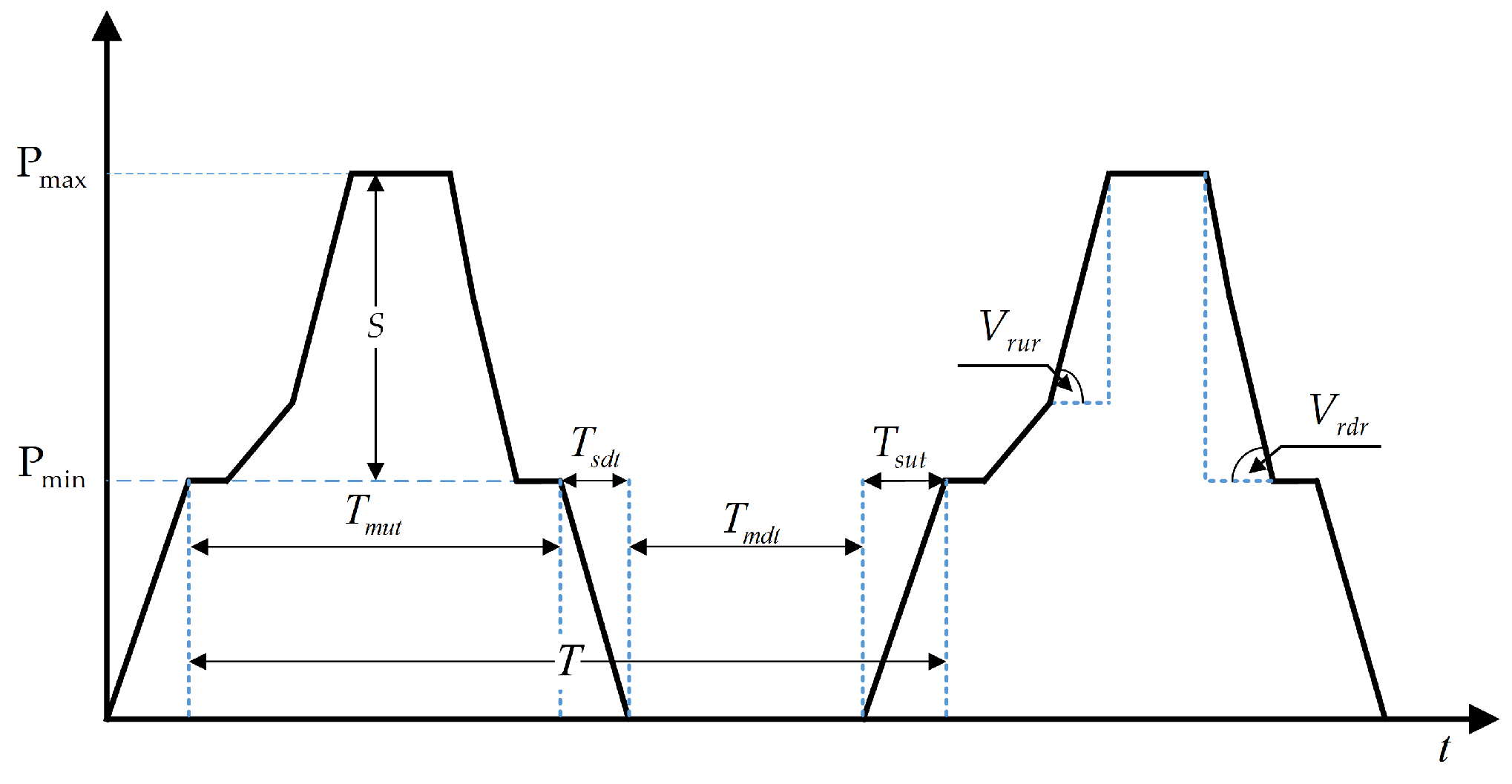
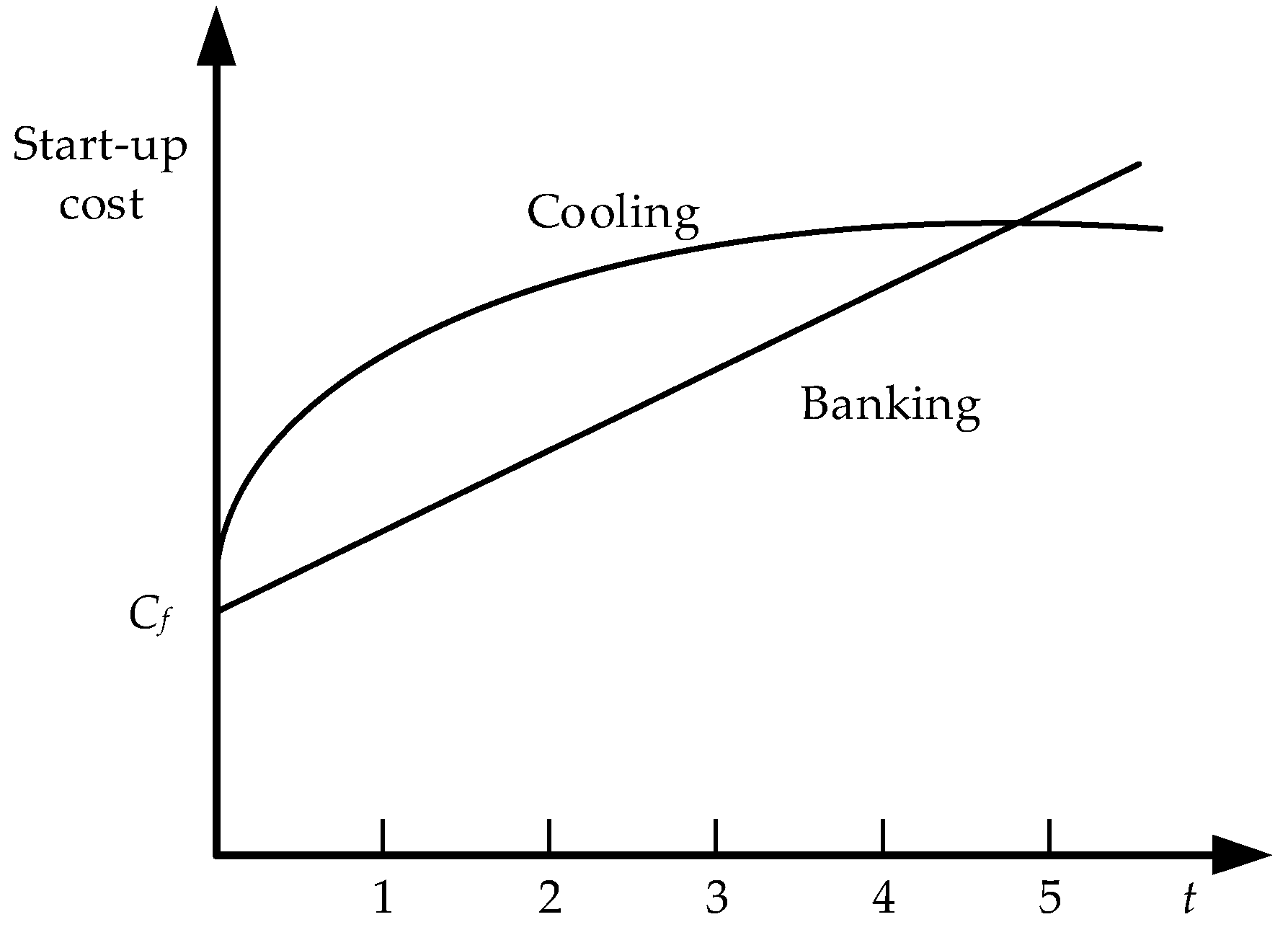
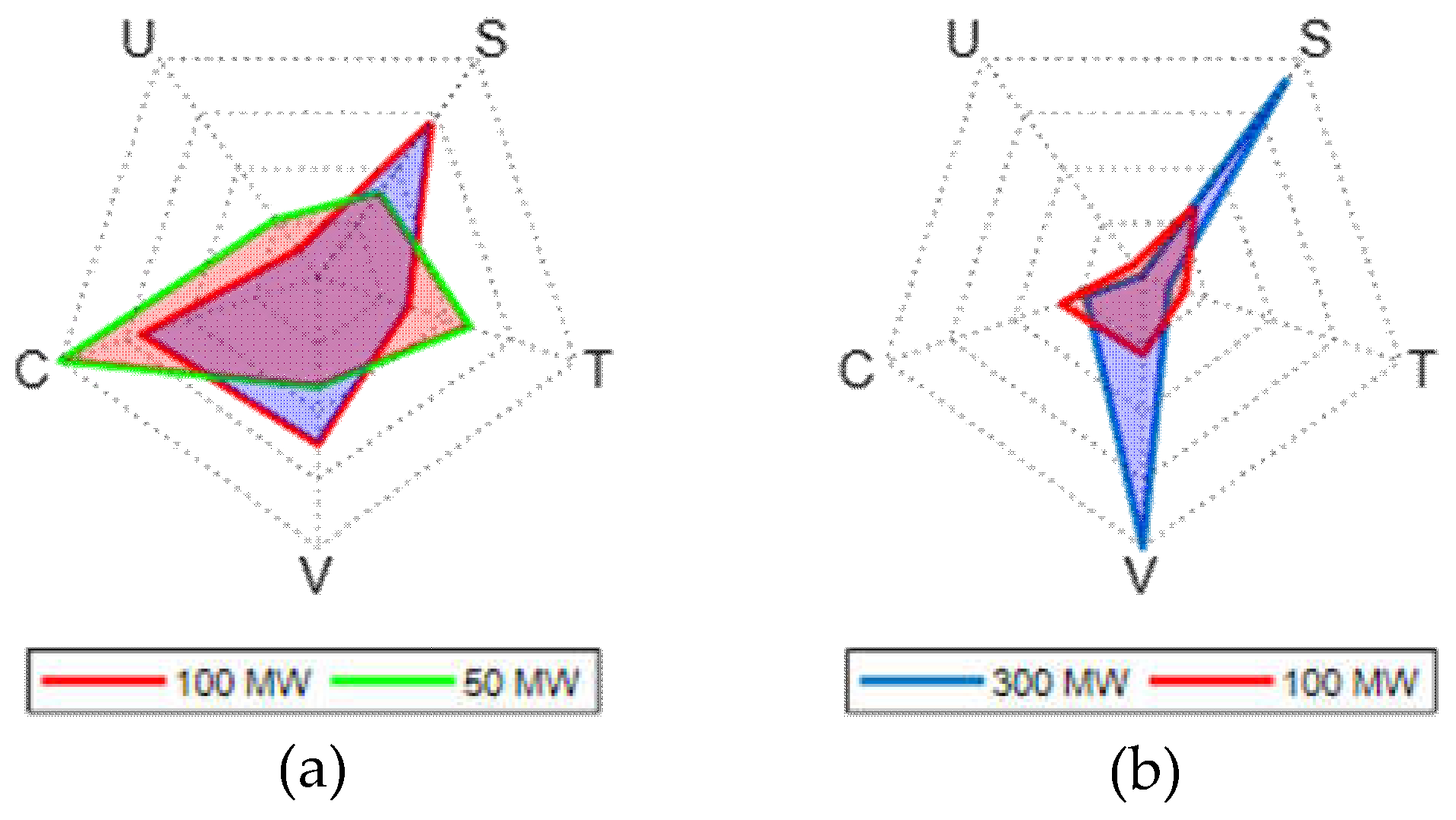

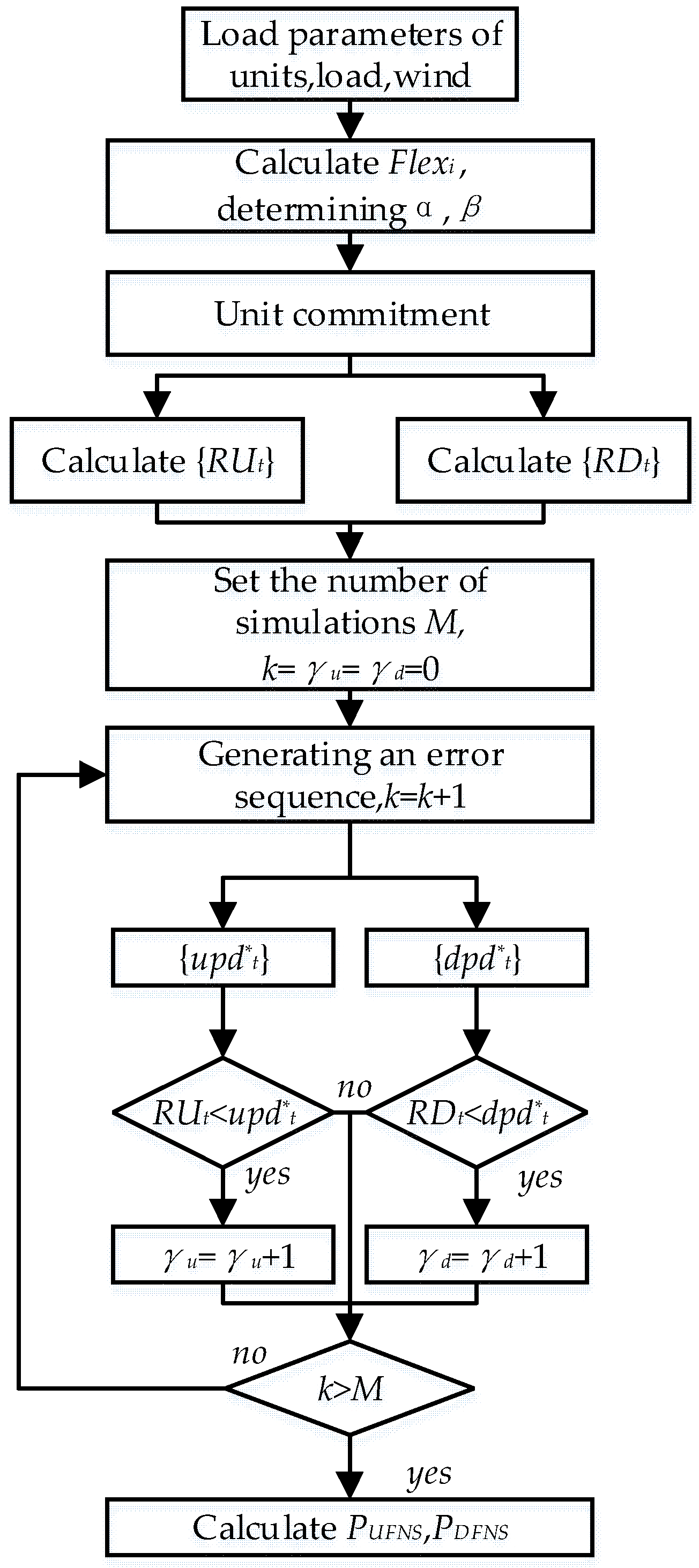
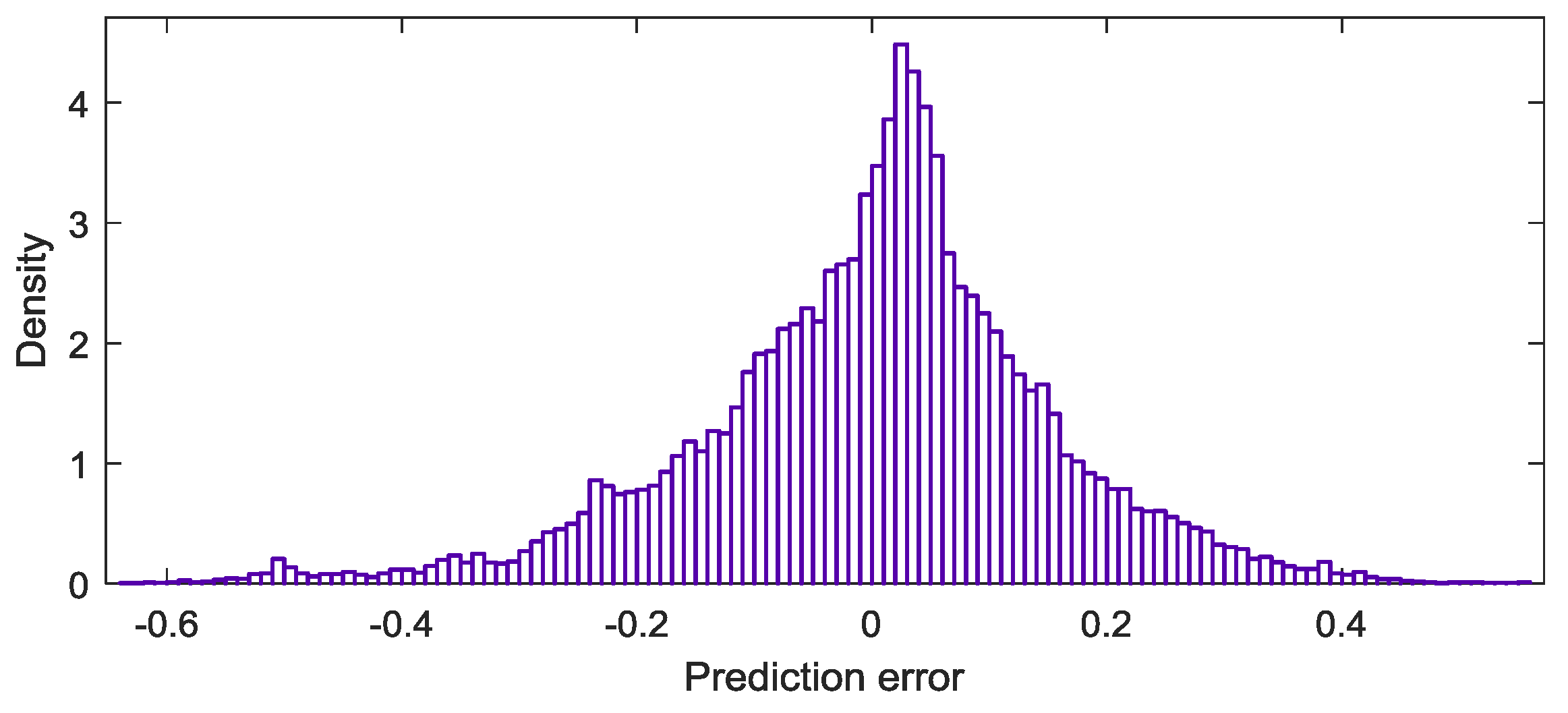
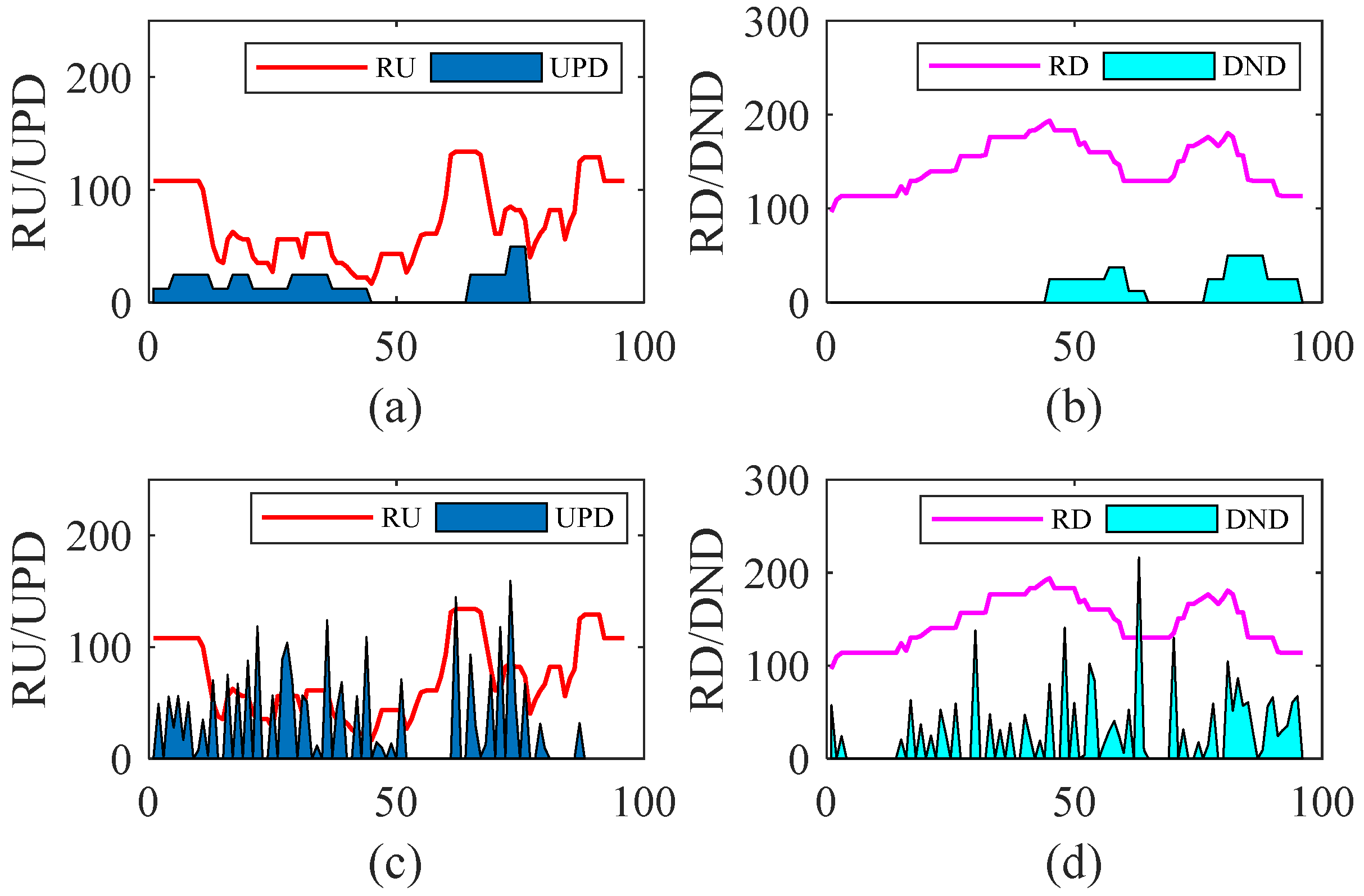
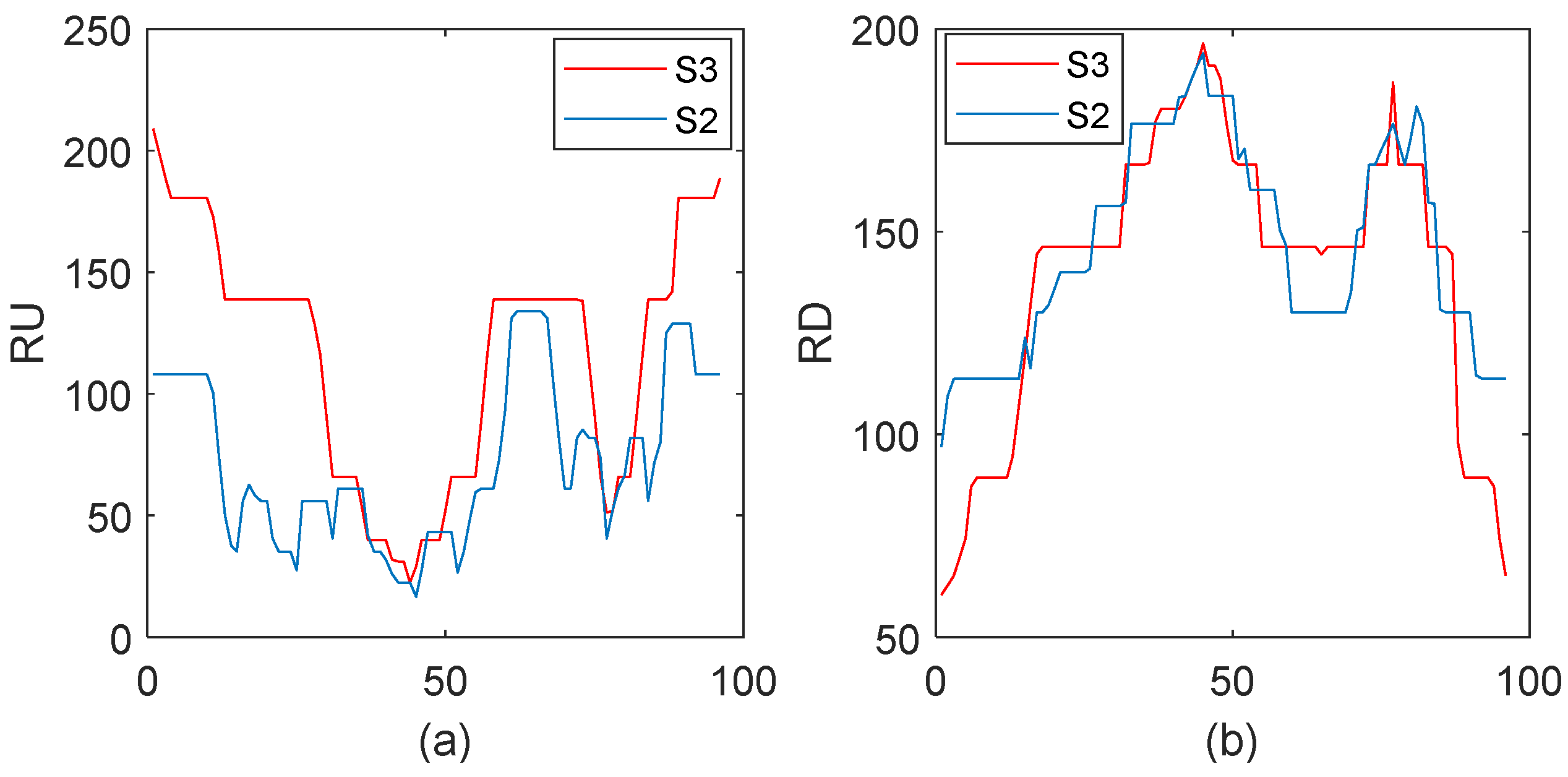

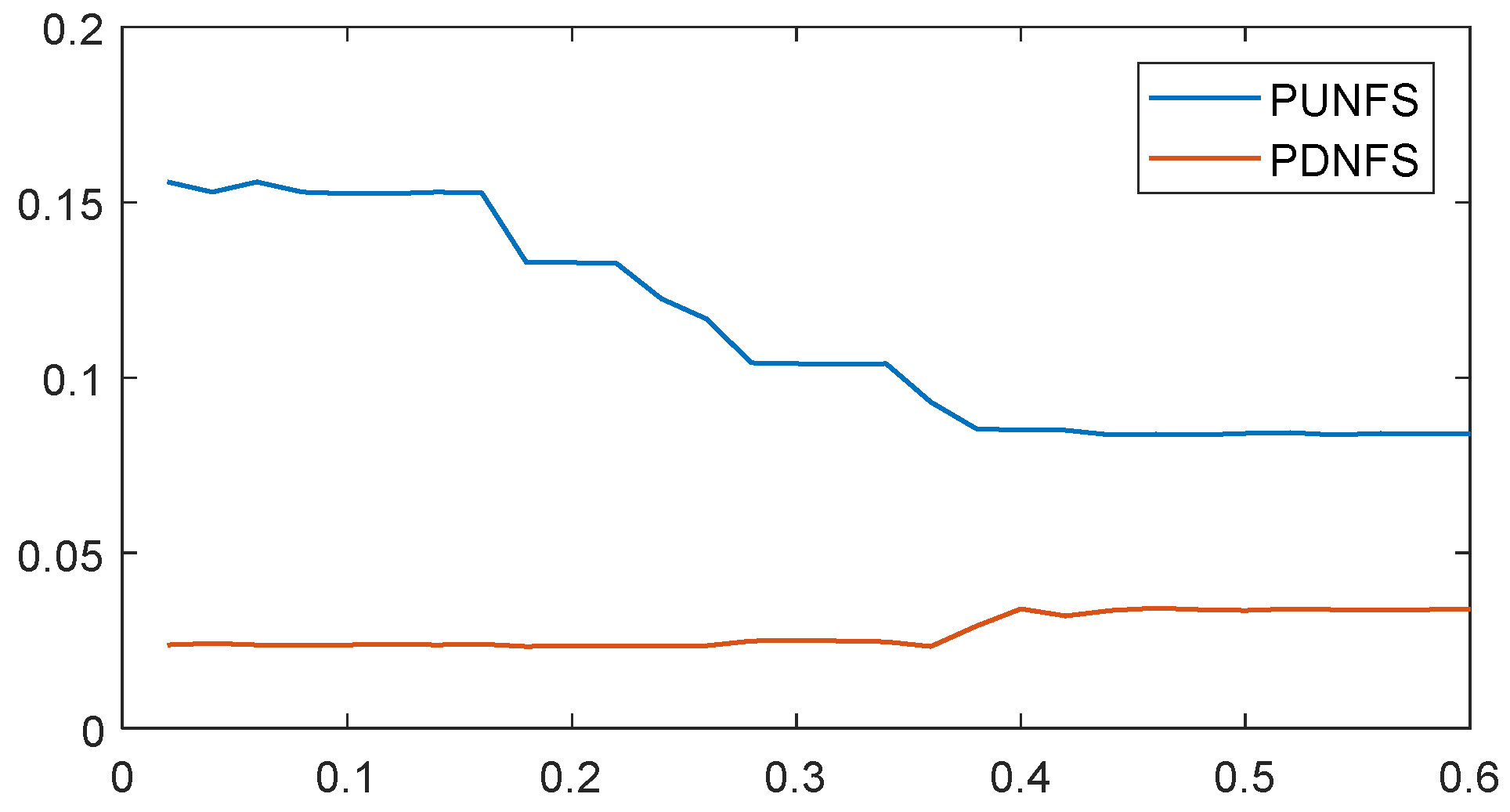
| Numerical Values | Verbal Scale | Explanation |
|---|---|---|
| 1 | Equal importance of both elements | Two elements contribute equally |
| 3 | Moderate importance of one indicator over another | Experience and judgment favor one indicator over another |
| 5 | Strong importance of one indicator over another | An indicator is strongly favored |
| 7 | Very strong importance of one indicator over another | An indicator is very strongly dominant |
| 9 | Extreme importance of one indicator over another | An indicator is favored by at least an order of magnitude |
| 2, 4, 6, 8 | Intermediate values | Used to compromise between two judgments |
| Index | S | V | T | C | U |
|---|---|---|---|---|---|
| Subjective weight | 0.228 | 0.210 | 0.327 | 0.084 | 0.150 |
| Objective weight | 0.195 | 0.199 | 0.198 | 0.180 | 0.227 |
| Comprehensive weight | 0.222 | 0.209 | 0.322 | 0.076 | 0.171 |
| Index | 1 | 2 | 3 | 4 | 5 | 6 | 7 | 8 | 9 | 10 |
|---|---|---|---|---|---|---|---|---|---|---|
| Pmax | 455 | 455 | 130 | 130 | 162 | 80 | 85 | 55 | 55 | 55 |
| Flex | 126.50 | 126.61 | 60 | 60.14 | 69.15 | 66.15 | 60.89 | 143.58 | 143.51 | 143.46 |
| Strategies | S1 | S2 | S3 | S4 |
|---|---|---|---|---|
| k | 0 | 10% | 10% | 10% |
| α | 0 | 0 | 0.2 | 0.35 |
© 2018 by the author. Licensee MDPI, Basel, Switzerland. This article is an open access article distributed under the terms and conditions of the Creative Commons Attribution (CC BY) license (http://creativecommons.org/licenses/by/4.0/).
Share and Cite
Guo, T.; Gao, Y.; Zhou, X.; Li, Y.; Liu, J. Optimal Scheduling of Power System Incorporating the Flexibility of Thermal Units. Energies 2018, 11, 2195. https://doi.org/10.3390/en11092195
Guo T, Gao Y, Zhou X, Li Y, Liu J. Optimal Scheduling of Power System Incorporating the Flexibility of Thermal Units. Energies. 2018; 11(9):2195. https://doi.org/10.3390/en11092195
Chicago/Turabian StyleGuo, Tong, Yajing Gao, Xiaojie Zhou, Yonggang Li, and Jiaomin Liu. 2018. "Optimal Scheduling of Power System Incorporating the Flexibility of Thermal Units" Energies 11, no. 9: 2195. https://doi.org/10.3390/en11092195
APA StyleGuo, T., Gao, Y., Zhou, X., Li, Y., & Liu, J. (2018). Optimal Scheduling of Power System Incorporating the Flexibility of Thermal Units. Energies, 11(9), 2195. https://doi.org/10.3390/en11092195




